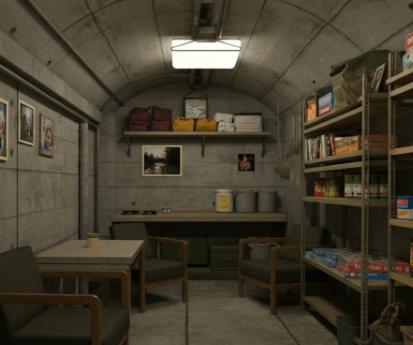The demand for personal bunkers has skyrocketed by 700% over the past decade, with over 10,000 Americans now owning private underground shelters on their property. Whether you’re preparing for natural disasters, seeking a secure storage space, or want peace of mind, learning how to build an underground bunker on your land has become a priority for many property owners across the country. Recent studies indicate that 73% of bunker owners report feeling significantly more secure about their family’s safety after installing a bunker. However, building a bunker isn’t just about digging a hole – it requires proper planning, permits, engineering expertise, and the right piece of land to make it work effectively. Many landowners discover that their current property may not be suitable for bunker construction due to soil conditions, zoning restrictions, or space limitations. That’s where renowned real estate investors and cash land buyers, Steve Daria and Joleigh, can help you find the perfect property to build an underground bunker on your land. With their extensive knowledge of land suitability and quick cash purchasing process, they’ve helped countless clients secure ideal properties for bunker construction projects. Looking to find the right land for your bunker project? Book a free discussion with Steve Daria and Joleigh today to discover how they can help you acquire the right property quickly and efficiently, turning your underground bunker dreams into reality.
Key Points
- Check Local Building Permits and Zoning Laws: Check with your local building department to learn about permits and zoning rules for underground structures. Many areas have specific rules regarding depth limitations and property line setbacks that may impact your bunker plans.
- Test Your Soil and Site Conditions: Hire a professional to analyze your soil composition and check for groundwater levels on your property. Poor drainage or unstable soil can render construction impossible or make it extremely costly to complete properly.
- Design Proper Ventilation and Safety Systems: Work with engineers to plan adequate air filtration and emergency exit routes for your bunker. Without proper airflow systems, your shelter could become dangerous during actual emergencies.
- Choose Quality Construction Materials: Select reinforced concrete or steel materials that resist soil pressure and moisture damage over time. Quality waterproofing and structural materials prevent costly repairs and ensure your bunker remains functional for years.
- Install Essential Utilities and Emergency Power: Plan electrical, water, and waste systems before finishing construction. Include backup power sources that work independently when main utilities fail during emergencies.
What is an underground bunker, and why would I need one on my land?
An underground bunker is a shelter constructed below ground to protect people and valuable items from danger.
These sturdy rooms are typically constructed with thick concrete or steel to withstand storms, disasters, or prolonged power outages.
Learning how to build an underground bunker on your land can help you feel safer during emergencies like tornadoes or hurricanes.
A bunker is an ideal place to store food, water, and supplies, ensuring you are always prepared.

It gives peace of mind knowing your family has a safe spot to go if something bad happens.
Some people use their bunkers to store vegetables, canned food, or essential tools for emergencies.
Bunkers stay cool throughout the year, which helps keep items fresh and safe.
Building a bunker means you are prepared for the unexpected and can better protect the people you care about.
Get Started: Get Your Cash Offer Below…
We are direct land buyers. There are no commissions or fees and no obligation whatsoever. Start below by sharing where your property is and where we can send your offer…
How much does it typically cost to build an underground bunker?
The cost to build an underground bunker on your land can vary significantly depending on its size, materials, and the features you want to include.
Basic DIY bunkers using simple materials, such as shipping containers, can cost between $10,000 and $30,000 for smaller structures.
Mid-range bunkers with proper concrete construction, ventilation systems, and basic utilities typically cost between $50,000 and $150,000.
High-end luxury bunkers with advanced security features, multiple rooms, and sophisticated life support systems can cost anywhere from $200,000 to over $1 million.
The final price depends on excavation depth, soil type, labor costs, and permit fees.
You’ll also need to budget for excavation work, which can add $5,000 to $20,000 depending on access to your site and soil conditions.
Additional costs include electrical work, plumbing, waterproofing, and any specialized equipment, such as air filtration systems or backup generators.
Obtaining quotes from multiple contractors and having a detailed plan will help you understand the true cost of your project before it begins.
How deep should I build my underground bunker?
- Start with 6-8 Feet for Basic Protection: Most homeowners find that a depth of 6-8 feet provides sufficient protection from severe weather and meets their basic security needs. This depth is easier to dig, costs less money, and still gives you a safe space during storms or emergencies.
- Go 10-12 Feet Deep for Enhanced Security: If you want stronger protection from extreme weather or need more privacy, consider digging 10-12 feet down. This deeper level offers better insulation, making your bunker harder to detect from ground level.
- Consider 15+ Feet for Maximum Protection: For the highest level of safety and security, bunkers built 15 feet or deeper provide excellent protection from most threats. However, these deeper bunkers require special engineering and waterproofing, and they cost significantly more to build.
- Check Local Water Table and Soil Conditions: Before building an underground bunker on your land, test your soil and determine the depth of groundwater in your area. If water sits close to the surface, you may need to build shallower or install expensive drainage systems.
- Follow Local Building Code Requirements: Most areas have rules about how deep you can dig without special permits or safety measures. Check with your local building department first, as some places limit depth to 6-10 feet without engineering plans and professional inspections.

What permits do I need to build an underground bunker?
When you decide to build an underground bunker on your land, you’ll need several permits to make sure your project meets local safety rules and building codes.
The most important permit is a building permit, which your local building department will give you after they approve your construction plans.
An excavation permit is essential for safely digging deep holes, particularly when working near underground utilities like gas lines or water pipes.
If your bunker will have electricity, you must get an electrical permit so a licensed electrician can install wiring that meets safety standards.
For bunkers with plumbing features, such as toilets or sinks, a plumbing permit is required to ensure proper waste removal and water connections.
Some areas also require structural engineering plans if your bunker is deeper than a certain depth or larger than a specific size.
You may need additional permits for septic systems, well water connections, or special ventilation systems, depending on the features of your bunker.
Before starting any work, contact your local building department to obtain a comprehensive list of permits required for your specific project and location.
How long does it take to build an underground bunker?
- Simple Bunkers Take 2-4 Weeks: Basic bunkers with minimal features can be completed within 2-4 weeks if all necessary permits are ready. This timeline works best for small, shallow bunkers without complex utility systems or luxury features.
- Mid-Range Projects Need 6-12 Weeks: You should expect 6-12 weeks for average-sized projects if you decide to build an underground bunker on your land. This includes time for excavation, concrete work, waterproofing, and installing basic electrical and ventilation systems.
- Complex Bunkers Require 3-6 Months: Large bunkers with multiple rooms, advanced security features, and full utility systems take much longer to complete. These projects need more planning time, specialized materials, and detailed work that cannot be rushed safely.
- Weather and Soil Conditions Affect Speed: Bad weather, like rain or snow, can cause weeks-long delays in construction work. Rocky soil or high water tables also slow down digging and may require special equipment or techniques.
- Permit Approval Can Add 2-8 Weeks: Before you can build an underground bunker on your land, you must wait for the building permits and inspections to be approved. Obtaining all required permits typically adds 2-8 weeks to your project timeline, depending on the local government’s processing speed.
How do I maintain my underground bunker after construction?
Maintaining your underground bunker after construction requires regular care to keep it safe and functional.
Once you have built an underground bunker on your land, inspect it monthly for water leaks, cracks, or moisture issues that could damage your shelter.
Check your ventilation system every three months to ensure clean air flow and replace filters as needed.
Test all electrical equipment, including lights, generators, and emergency systems, at least twice a year to ensure everything functions properly.
Rotate stored food and supplies regularly, checking expiration dates on medical items and batteries to ensure they are up to date.
Clean your bunker thoroughly during each visit to prevent mold and pest problems.
Schedule annual professional inspections to check structural integrity and major systems.
When you build an underground bunker on your land, you’re making a long-term investment that needs ongoing attention.
Maintain detailed records of all repairs and replacements over time.
Ready to protect your investment? Contact bunker maintenance professionals today to create a customized care plan for your underground shelter.
**NOTICE: Please note that the content presented in this post is intended solely for informational and educational purposes. It should not be construed as legal or financial advice or relied upon as a replacement for consultation with a qualified attorney or CPA. For specific guidance on legal or financial matters, readers are encouraged to seek professional assistance from an attorney, CPA, or other appropriate professional regarding the subject matter.
